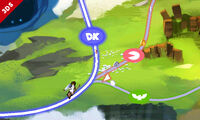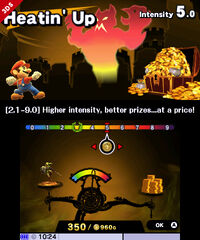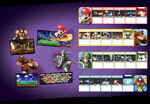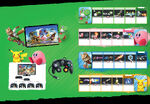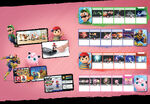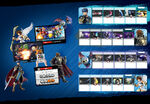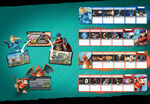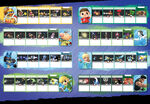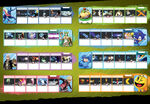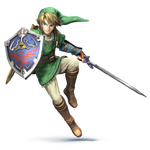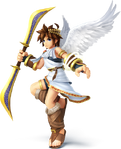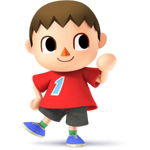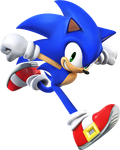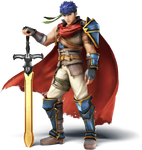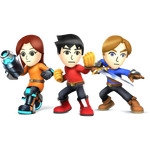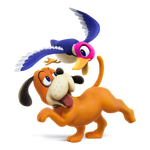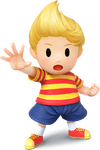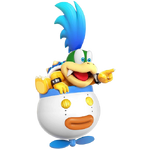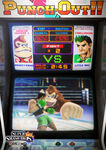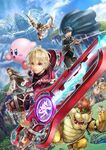No edit summary Tag: sourceedit |
No edit summary Tag: sourceedit |
||
| Line 152: | Line 152: | ||
*[[Skyworld]] (Kid Icarus)* |
*[[Skyworld]] (Kid Icarus)* |
||
*[[Smashville]] (Animal Crossing)* |
*[[Smashville]] (Animal Crossing)* |
||
| + | *[[Suzaku Castle]] (Street Fighter II)** |
||
*[[Temple]] (Legend of Zelda)* |
*[[Temple]] (Legend of Zelda)* |
||
*[[The Great Cave Offensive]] (Kirby Super Star) |
*[[The Great Cave Offensive]] (Kirby Super Star) |
||
*[[Town and City]] (Animal Crossing: City Folk) |
*[[Town and City]] (Animal Crossing: City Folk) |
||
| − | * |
+ | *[[Wii Fit Studio]] (Wii Fit) |
*[[Windy Hill]] (Sonic Lost World) |
*[[Windy Hill]] (Sonic Lost World) |
||
*[[Woolly World]] (Yoshi's Woolly World) |
*[[Woolly World]] (Yoshi's Woolly World) |
||
| Line 196: | Line 197: | ||
*[[Battlefield (SSBWU/3DS)|Battlefield]] |
*[[Battlefield (SSBWU/3DS)|Battlefield]] |
||
*[[Boxing Ring]] (Punch-Out!!) |
*[[Boxing Ring]] (Punch-Out!!) |
||
| + | *[[Dream Land 64]] (Kirby's Dream Land)*** |
||
*[[Final Destination (SSBWU/3DS)|Final Destination]] |
*[[Final Destination (SSBWU/3DS)|Final Destination]] |
||
*[[Gaur Plains]] (Xenoblade Chronicles) |
*[[Gaur Plains]] (Xenoblade Chronicles) |
||
Revision as of 04:54, 14 June 2015
Super Smash Bros. for Nintendo 3DS and Super Smash Bros. for Wii U (大乱闘スマッシュブラザーズ for Nintendo 3DS/Wii U Dairantō Sumasshu Burazāzu fō Nintendō Surī Dī Esu / Wī Yū?) (Often referred by fans as Super Smash Bros. 4 (SSB4) and Sm4sh) is a Nintendo 3DS and Wii U game. It was developed by Namco Bandai Games Inc. and Sora, and was published by Nintendo. It is the fourth installment in the series. These two games bring the total of games in this franchise up to five.
Characters
- Main article: Characters
The following 51 characters are playable in this game (54 if all three Mii Fighters are considered separate characters - making it the game with the most characters).
It should be noted, however, that some unlockable characters in the 3DS version are starter characters in the Wii U version. This was a personal choice of Masahiro Sakurai, who opted with his team to make said characters starters as they were unlockable in the 3DS to save players who already had this version to take extra time to unlock all, but still have fun unlocking hidden content.
It has been confirmed that more characters will become downloadable in the future, and these characters will be decided by fans via the Smash Bros. Fighter Ballot.
Amiibo
Amiibos are part of a new system introduced for Smash Bros. for WiiU and 3DS, that uses near field communication through special figurines of the respective characters, that can be bought separately. Through this, players bring the characters to the game as special CPU player, which can level up and be customized, learning more as they improve and interact with the player and other CPUs.
Stages
There are a total of 76 stages across both games; some are shared between versions (* indicates that the stage returns from a previous game) (**means that it is DLC). Some stages, such as Gaur Plains and Final Destination, are slightly different between the two versions. The Wii U version has 47 Stages, while the 3DS version has 34.
Wii U (47)
- 75m (Donkey Kong)*
- Big Battlefield
- Bridge of Eldin (The Legend of Zelda: Twilight Princess)*
- Castle Siege (Fire Emblem Series)*
- Coliseum (Fire Emblem Series)
- Delfino Plaza (Super Mario Sunshine)*
- Duck Hunt (Duck Hunt)
- Flat Zone X (Game & Watch)
- Gamer (Game & Wario)
- Garden of Hope (Pikmin 3)
- Halberd (Kirby Super Star)*
- Jungle Hijinxs (Donkey Kong Country Returns)
- Kalos Pokémon League (Pokémon X and Y)
- Kongo Jungle 64 (Donkey Kong Country)*
- Lylat Cruise (Star Fox: Assault)*
- Luigi's Mansion (Luigi's Mansion)*
- Mario Circuit (Mario Kart)
- Mario Circuit (Brawl) (Mario Kart)*
- Mario Galaxy (Super Mario Galaxy)
- Mushroom Kingdom U (New Super Mario Bros. U)
- Miiverse (Miiverse)**
- Norfair (Metroid)*
- Onett (EarthBound)*
- Orbital Gate Assault (Star Fox: Assault)
- Pac-Land (Pac-Land)
- Palutena's Temple (Kid Icarus: Uprising)
- Pilot Wings (Pilotwings/Wii Sports Resort)
- Pokémon Stadium 2 (Pokémon Stadium 2)*
- Port Town Aero Dive (F-Zero)*
- Pyrosphere (Metroid: Other M)
- Skyloft (The Legend of Zelda: Skyward Sword)
- Skyworld (Kid Icarus)*
- Smashville (Animal Crossing)*
- Suzaku Castle (Street Fighter II)**
- Temple (Legend of Zelda)*
- The Great Cave Offensive (Kirby Super Star)
- Town and City (Animal Crossing: City Folk)
- Wii Fit Studio (Wii Fit)
- Windy Hill (Sonic Lost World)
- Woolly World (Yoshi's Woolly World)
- Wrecking Crew (Wrecking Crew)
- Wuhu Island (Wii Sports)
- Yoshi's Island (Super Mario World)*
3DS (34)
- 3D Land (Super Mario 3D Land)
- Arena Ferox (Fire Emblem: Awakening)
- Balloon Fight (Balloon Fight)
- Brinstar (Metroid)*
- Corneria (Star Fox)*
- Distant Planet (Pikmin)*
- Dream Land (Kirby's DreamLand)
- Find Mii (Find Mii II/Street-Pass Quest II)
- Flat Zone 2 (Game & Watch)*
- Gerudo Valley (The Legend of Zelda: Ocarina of Time 3D)
- Green Hill Zone (Sonic The Hedgehog)*
- Golden Plains (New Super Mario Bros. 2)
- Jungle Japes (Donkey Kong Country)*
- Living Room (Nintendogs)
- Magicant (Mother)
- Mushroomy Kingdom (Super Mario Bros.)*
- Mute City (F-Zero)
- Pac-Maze (Pac-Man)
- Paper Mario (Paper Mario: Sticker Star/Paper Mario: The Thousand Year Door)
- PictoChat 2 (Nintendo DS)
- Prism Tower (Pokémon X and Y)
- Rainbow Road (Mario Kart 7)
- Reset Bomb Forest (Kid Icarus: Uprising)
- Spirit Train (The Legend of Zelda: Spirit Tracks)
- Tomodachi Life (Tomodachi Life)
- Tortimer Island (Animal Crossing: New Leaf)
- Unova Pokémon League (Pokémon Black and White)
- WarioWare, Inc. (WarioWare)*
- Yoshi's Island (Yoshi)*
Both Versions
- Battlefield
- Boxing Ring (Punch-Out!!)
- Dream Land 64 (Kirby's Dream Land)***
- Final Destination
- Gaur Plains (Xenoblade Chronicles)
- Wily Castle (Mega Man 2)
Items
New Items
- Back Shield (Kid Icarus: Uprising)
- Beehive (Animal Crossing series)
- Beetle (Legend of Zelda: Skyward Sword)
- Spiny Shell (Mario Kart series)
- Bombchu (Legend of Zelda series)
- Boomerang (Super Mario 3D Land)
- Bullet Bill (Super Mario Bros. series)
- Chest (original)
- Cucco (Legend of Zelda series)
- Daybreak (Kid Icarus: Uprising)
- Drill Arm (Kid Icarus: Uprising)
- Fairy Bottle (Legend of Zelda series)
- Fire Bar (Super Mario Bros. series)
- Galaga Ships (Galaga)
- Grass (Super Mario Bros. series)
- Gust Bellows (Legend of Zelda: Skyward Sword)
- Hocotate Bomb (Pikmin series) **
- Killer Eye (Kid icarus: Uprising)
- Master Ball (Pokémon series)
- Ore Club (Kid Icarus: Uprising)
- POW Block (Super Mario Bros. series) **
- Rocket Belt (Pilot Wings)
- Special Flag (Rally-X)
- Steel Diver (Steel Diver)
- Tanooki Leaf (Super Mario Bros. series)
- X Bomb (Kid Icarus: Uprising)
Returning Items
- Assist Trophy (original)
- Banana Peel (Mario Kart series)
- Barrel (original)
- Beam Sword (original)
- Blast Box (Original)
- Bob-omb (Super Mario Bros. series)
- Bumper (original)
- Bunny Hood (Legend of Zelda series)
- Capsule (original)
- Crate (original)
- Deku Nut (Legend of Zelda series)
- Dragoon (Kirby Air Ride)
- Fire Flower (Super Mario Bros. series)
- Food (original)
- Franklin Badge (Mother Series)
- Freezie (Mario Bros.)
- Green Shell (Super Mario Bros. series)
- Golden Hammer (original)
- Gooey Bomb (original)
- Hammer (Donkey Kong)
- Heart Container (Legend of Zelda series)
- Home-run Bat (original)
- Hothead (Super Mario World)
- Lightning Bolt (Mario Kart series)
- Lip's Stick (Panel de Pon)
- Maxim Tomato (Kirby series)
- Metal Box (Mario series)
- Motion-Sensor Bomb (original)
- Mr. Saturn (Mother Series)
- Party Ball (original)
- Pitfall (Animal Crossing)
- Poké Ball (Pokémon series)
- Poison Mushroom (Super Mario Bros. series)
- Ray Gun (original)
- Rolling Crate (original)
- Sandbag (original)
- Screw Attack (Metroid series)
- Smart Bomb (Star Fox series)
- Smash Ball (original)
- Smoke Ball (original)
- Soccer Ball (Soccer)
- Spring (Donkey Kong)
- Starman (item) (Super Mario Bros. series)
- Star Rod (Kirby series)
- Super Scope (original)
- Super Mushroom (Super Mario Bros. series)
- Superspicy Curry (Kirby series)
- Team Healer (original)
- Timer (original)
- Unira (Clu Clu Land)
- Warp Star (Kirby series)
The Hocotate Bomb (similar to Olimar's Final Smash) and the POW Block (once a stage hazard) return as items.
Pokémon
In order to increase the rate of rare Pokémon appearing in battle, there are now two types of Poké Balls: the traditional red and white Poké Ball, which summons any Pokémon, and the Master Ball, which summons only rare and legendary Pokémon. However, Goldeen may be summoned from a Master Ball (possibly a prank).
New Pokémon
- Abomasnow
- Arceus
- Chespin
- Darkrai
- Dedenne
- Eevee
- Fennekin
- Fletchling
- Genesect
- Giratina
- Gogoat
- Inkay
- Keldeo
- Kyurem
- Meloetta
- Milotic
- Oshawott
- Palkia
- Reshiram
- Snivy
- Spewpa
- Swirlix
- Victini
- Xerneas
- Zoroark
Returning Pokémon
- Bellossom
- Deoxys
- Electrode
- Entei
- Gardevoir
- Goldeen
- Kyogre
- Latias
- Lugia
- Meowth
- Metagross
- Mew
- Moltres
- Snorlax
- Suicune
- Staryu
- Togepi
Assist Trophies
New Assist Trophies
- Ashley (WarioWare)
- Chain Chomp (Super Mario)
- Color TV-Game 15 (Color TV-Game)
- Dark Samus (Metroid Prime)
- Dillon (Dillon's Rolling Western)
- Dr. Kawashima (Brain Age)
- Elec Man (Mega Man)
- Ghirahim (The Legend of Zelda: Skyward Sword)
- Isabelle (Animal Crossing: New Leaf)
- Magnus (Kid Icarus: Uprising)
- Midna (The Legend of Zelda: Twilight Princess)
- Mother Brain (Metroid)
- Nightmare (Kirby)
- Ghosts (Pac-Man)[1]
- Phosphora (Kid Icarus: Uprising)
- Prince of Sablé (For the Frog the Bell Tolls)
- Riki (Xenoblade Chronicles)
- Sheriff (Sheriff)[2]
- Skull Kid (The Legend of Zelda: Majora's Mask)
- Starman (EarthBound)[3]
- Takamaru (Mysterious Murasame Castle)
Returning Assist Trophies
- Andross (Star Fox)
- Devil (Devil World)
- Dr. Wright (SimCity)
- Hammer Bro (Super Mario)
- Infantry and Tanks (Advance Wars)[4]
- Jeff (EarthBound)[5]
- Kat and Ana (WarioWare)
- Knuckle Joe (Kirby)
- Lakitu (Super Mario)
- Lyn (Fire Emblem)
- Metroid (Metroid)
- Nintendog (Nintendogs)
- Saki Amamiya (Sin and Punishment)
- Samurai Goroh (F-Zero)
- Shadow the Hedgehog (Sonic the Hedgehog)
- Starfy (The Legendary Starfy)
- Tingle (The Legend of Zelda)
- Waluigi (WarioWare)
Modes
Much like previous installations, the new Smash Bros. have different modes, however some are exclusive for each version of the game. Unlike the previous game is there no official story mode.
Smash Mode and 8-Player Smash
Also known as "VS Mode", it is the traditional 4-player battle that can be done with either players or CPUs. Additionally, the Wii U version has the exclusive 8-Player Smash, which allow, as the name suggests, up to 8 players to play simultaneously, however the range of maps is smaller, meaning not all stages can be played with 8 players.
Classic Mode
3DS version
In the new, modified version of Classic Mode, players choose different paths as they progress through a "world map" to fight against waiting CPU opponents.
Other than battling the usual fighters in one-on-one fights, there is also the possibility of fighting giant or metal fighters, team battles with CPU players both aiding and attacking the player, and matches where the player must defeat opponents one after another or in groups.
Players are able to alter their "Fighter Balance": a system where gold is spent to adjust the intensity level. The higher the intensity, the stronger opponents will be, and the greater a player's rewards will be when victorious. Among those rewards are gold, trophies and items for character customization.
Before the player starts a level, a roller appears and determines the player's rewards. Rewards in red are for customization, green ones are trophies, and yellow means gold.
Wii U version
In the Wii U version, the trophy of the player's character is put in an arena along with other characters' trophies. The player can move his trophy around the arena, and if it touches a group of trophies, it will be tossed into a battle with those characters (a faint image of the stage will be under the base of the trophies). After the fight, all the defeated characters' trophies will be launched out of the arena, and the remaining trophies will organize in new groups.
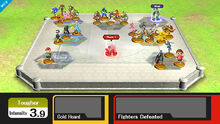
Along with normal and 8-player matches, intruders may appear randomly before matches, being either metal or giants characters. In team battles, instead of a random CPU companion, you choose your partner from the characters you defeated in previous battles. There is also a rival that can be challenged anytime; the longer you wait to battle him, more powerful will be, but it will also give more rewards when defeated.
The Fighter Balance and Reward Roller are kept from the 3DS version.
This is also the first Smash Bros. game where Classic Mode allows two-player mode.
Stadium Mode
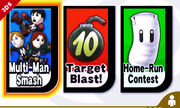
A mode comprised of the Multi-Man Smash, the new Target Blast and the Home-Run Contest.
The score for these games effect the player's Global Smash Power, by either increasing or decreasing it, making each time count.
In Multi-Man Smash the player fights against all three types of Miis, with randomly generated appearances. Like in Smash Bros. Brawl, it allows two-player mode.
Target Blast is played similarly to Home Run Contest, in a nod similar to Angry Birds. However, players will be presented to a giant bomb instead of the Sandbag, and must inflict it enough damage to create the biggest explosion possible by racking up points from obstacles and targets waiting to be destroyed. Much like in Home Run Contest, there is a 10 second timer, and after it expires the bomb will explode. Getting a good score depends on launching the bomb to areas rich with targets, getting the timing of the explosion just right, and using the explosive blocks found around the stage to maximum effect. It allows two player mode, however in form of a versus battle: each player get its turn to launch the bomb, rather than both players racking up damage against the bomb simultaneously. The player with most points wins.
Home-Run Contest now features a strong barrier in the arena, allowing players to rack up damage for longer time. Like in Smash Bros. Brawl, it allows two-player mode.
For Fun and For Glory
Online gameplay has been completely reworked, where players can choose between two new modes:
- For Fun: stage select is random (Final Destination is excluded from this), all items available, Smash battles only (free for all up to 4 players), and only wins are recorded.
- For Glory: stage select is restricted to Omega Stages (Final Destination-type variant of existing stages), no items available, 1-1 battles possible, and both wins and loses are recorded. Additionally, players can freely customize those rules when playing with friends.
Smash Run
An exclusive mode for the 3DS, where up to four players can compete in two separate instances: one where they collect power-ups in a large maze-like stage, and another one where they fight each other in a normal stage, using the power-ups each character has picked up to their advantage.
Smash Tour
An exclusive game mode for the Wii U, where up to four players can play a Mario Party style board game. Players can collect characters and power ups for a final fight, but it is possible to lose them through traps and secondary fights. There are three board sizes, and also different options for how many turns you take.
Special Orders
An exclusive mode to the Wii U, it consist in series of random challenges that give various rewards when completed; either custom parts, trophies or gold. The mode is presented by Master Hand and Crazy Hand, each with its unique way to play. To play Crazy Orders you either need to earn a ticket or pay a fee.
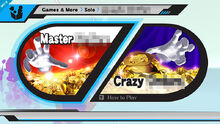
Master Orders
Every time you enter this mode, 3 random-created challenges of varying difficulty and entry fee (gold) to play will be presented to the player; every challenge with different battle rules, special powers for fighters and even psychics laws like altered gravity. Each challenge can only be tried once, winning allows you to get the secret reward, if you fail you get nothing. After playing a challenge, a new set of 3 will appear.
Crazy Orders
It costs 5000 gold or a free pass to play this mode (free passes are gained by playing various modes, such as Classic and Smash Tour). In Crazy Orders, you have a 10-minute time to complete various challenges, similar to the ones in Master Orders, and 3 are presented in each "round", with your damage percent carried over in each round. You can stop at any time during this, bringing you against a Stamina fight with Crazy Hand. The more rounds you played, more powerful Crazy Hand will be at the end and it can even be accompanied by CPU characters. You will only get your rewards after beating Crazy Hand, if at any time you lose a challenge or run out of time, Crazy Orders will end and you'll only recieve a small portion of your reward stash.
Changes from Brawl and New Features
Gameplay changes
- Nintendo released a GameCube Controller Adapter that allows to connect up to four original GameCube controllers to play Smash Bros. A Wii U version of the GameCube controller was also released as a special edition, with a more aesthetic design.
- Holding the Right Control Stick (C-Stick on the Gamecube controller) now charges Smash Attacks.
- This is the first Smash Bros. game that allows up to 8 players simultaneously in Versus Mode. Additionally, other modes also have 5 or more characters in battle, in form of CPUs.
- The speed of the game is a balance between Brawl and Melee. This is to appeal to both casual and hardcore gamers after the lukewarm response by hardcore gamers to Brawl's more "floaty" mechanics.
- The game in general is remarkable for being the first Smash Bros. in the series to receive patch notes for character balance and bug fixes.
- The game now favors both casual and hardcore players, with the introduction of For Glory and For Fun online modes, as a way to please differences types of players.
- Hitstun has been increased, allowing characters to pull true combos again, but not as effective as in Melee. The new mechanics now increases the amount of time characters have to act out of hitstun when being launched, which is identified by the trail of smoke they produce when receiving strong knockback. This means it is no longer possible to cancel hitstun with command input.
- Directional Influence was originally different at the release of Smash Bros. for 3DS, where it was required to input a vector directly to the knockback's vector. This was dubbed "vectoring". However, in the patch Version 1.0.4 of the 3DS version, DI now functions like it was in the other games.
- Additionally, the SDI (Smash Directional Influence, also known as "Hitstun Shuffling") has been nerfed. The SDI multiplier of multi-hit attacks was drastically reduced, meaning those attacks are now much more difficult to escape via SDI than they were in the previous games (so in a sense, all multi-hit attacks have been buffed).
- Characters with consecutive standard attacks, such as Fox's infinite kick, can now input a finishing move to end the combo, dealing knockback. Little Mac was the first character seen performing this, in his official reveal trailer.
- Characters with wall cling, such as Lucario and Sheik, can use it for a near infinite amount of time consecutively; however each time they jump out and cling again, the time they can stay on the wall is cut by half. This timer is reset once the character lands on ground.
- Meteor Smashes now causes opponents to ground-bounce characters if the player hits them in the air back to the stage, similar to using a Meteor Smash attack against ground opponents. Victims can prevent from being bounced by teching once they hit the ground.
- Additionally, very few characters have attacks that always Meteor Smashes; many now have sourspots that still deal high knockback, but don't send opponents downwards. Some of the most notable characters affected by this are Samus, Ness and Ganondorf, known for having very reliable Down Aerials that always caused Meteor Smash.
- On the other hand, Meteor Cancelling is no longer possible, meaning that all Meteor Smashes are essentially spikes, increasing the effectiveness of Meteor Smashes.
- Additionally, very few characters have attacks that always Meteor Smashes; many now have sourspots that still deal high knockback, but don't send opponents downwards. Some of the most notable characters affected by this are Samus, Ness and Ganondorf, known for having very reliable Down Aerials that always caused Meteor Smash.
- Random Tripping has been removed. Forced tripping, however, remains, since the banana peel item is still present, as well as the individual character attacks that can cause tripping.
- Gliding has been removed. This means Charizard, Meta Knight and Pit no longer have an additional means of recovery.
- Swimming has been removed in the 3DS version, but does return in the Wii U version.
- Some attacks with wind effect (pushboxes) have increased pushing power depending on the opponents' current percentage.
- Much like Sakurai stated in one of his Miiverse posts, the difference of size between small and large characters is more noticeable than in Brawl; characters such as Bowser, Donkey Kong and King Dedede are remarkably larger than they were in Brawl comparing with other smaller characters such as Mario and Fox.
- In addition, heavy characters received a boost in both offense and defense to compensate their lack of speed and larger size, by adding more knockback to most of their moves as well super armor for attacks and even normally; Bowser, for example, can shrug off some weaker attacks without flinching even when not attacking.
- Character transformations mid-match have been completely removed from the game; Zero Suit Samus and Sheik are now separate characters from Samus and Zelda, respectively. Charizard is now also a stand-alone character, as opposed to previously being one of Pokemon Trainer's Pokémon.
- Tether Recovery can now be done from an even longer range than before, and better sweetspots the ledge. In addition, multiple characters can latch on the ledge, but the one that actually grabs hold is determined by the same rules as the standard ledge grab.
- Ledge mechanics have been reworked to improve the balance and meta-game:.
- To prevent the infamous edgehogging tactics and greatly expand the edge-game, a new ledge mechanic has been introduced, where a character will be automatically "kicked" off of the edge if another character tries to grab it. This doesn't cause damage, and makes edge-hogging kills no longer possible. Air time and damage percentage of a specific character now affect how much time he/she will be invincible while holding the ledge.
- planking is no longer possible, meaning players can no longer release and grab the ledge repeatedly to gain invincibility frames; after releasing the ledge, the player can't re-grab for a couple of frames afterwards. Also, re-grabbing the ledge multiple times won't give invincibility frames; there is now a cooldown for ledge invincibility.
- Sweetspotting the ledge is slightly more difficult than in Brawl, but not as much as in Melee; it is required the correct spacing in order to latch on, though. However, most Up Specials now have improved ledge-sweetspotting, preventing characters from dying when the recovery move pushes them below the platform slightly. Addtionally, it is still possible to grab the ledge backwards.
- Characters no longer have two different types of ledge attacks depending on their percentage.
- A mechanic has been implemented, called "Rage", by fans. It increases the player's knockback dealt when his/her character is at high percentages, functioning similar to Lucario's Aura mechanic, but much less powerful (however only affects the knockback, not the damage). Characters start gaining this effect from 50%, with a knockback cap when reaching 150%. This "Rage Mode" is made more visible after 100%, as characters begin emitting steam and flashing red.
- The effect of flashing and steam is also visually announce to the opponents and the player himself that the character is at his/her limit.
- As shown in the April's 7th Smash Direct, the characters' Special Moves can be customized to give certain results, such as Pit's arrows performing a spin after being fired, Kirby freezing characters instead of swallowing them or Mario's Fireball being much larger but slower or smaller but faster.
- During Play Nintendo - Super Smash Bros. Roundtable with Masahiro Sakurai, it has been further explained how that mechanic will function: each character have 2 variations of their original Special Attacks, totalizing 12 different Special Moves, 3 for each direction. However, to maintain the game's balance, these customizations will not be available for Online Mode "With Anyone", and can also be turned off in the game's options for other Modes.
- A new ranking system has been introduced, called Global Smash Power. Differentiating from the traditional leaderboards seen in other games and seen by Sakurai as a more "fair" than the current leaderboard system seen in most online games.
- Assist items (Assist Trophy, Pokeball, Master Ball) now only appear one at a time in the 3DS version. In the Wii U Version multiple can appear at a time.
- When running out of a platform or edge, characters do a smooth "hopping" that is followed by the normal falling animation. Also, if the characters takes no action before landing on another platform, they will immediately continue running once they hit the ground instead of the standard landing animation.
- Though originally there were plans to include a single player story mode, Sakurai has since changed his mind. There is no story mode in this installment of the game.
- However, short movies featuring newcomer characters introductions, like the ones introducing Villager, Wii Fit Trainer, and Mega Man, will take the place of the originally planned story mode cutscenes. These scenes, however, are not present on 3DS.
- Star KOs and Screen KOs are now random, meaning that a character killed over the upper blast line won't always have be of these animations; both of these KOs now have the same animation length. Additionally, they no longer occur near the end of a timed match or Sudden Death; being instead replaced by regular blast KOs.
- Almost all stages now have a "Final Destination version", which is a flat version of the respective stage, without any platforms or stage hazards. This is referred to as the stage's "Omega" version.
- In addition, players can set "Random Ω" in the options to automatically fight always in Omega Stages rather than manually selecting them.
- Multi-Man Mode no longer puts players to fight against clone characters such the Fighting Alloy Team in Brawl, but it's now the Fighting Mii Team where the player fights random generated Miis of all three classes.
- The Stage Builder in this game lets you build your own land using the Gamepad Style, with far more options than the Brawl version, allowing much more fluid terrain as opposed of the "blocky" ones in Brawl. It also lets you make ledges grabable, create pass-through platforms, and draw hazardous areas. Other features include launching barrels similar to the Donkey Kong games, and moving platforms whose distance and trajectory can be set by the player. Background screens are now animated, and players are able to build much larger stages than in Brawl.
Aesthetic changes
- Visually, the game is more stylized and "colorful" than Brawl, with colors being more saturated, as well sound effects being more discreet but yet cartoonish.
- While in Brawl characters had a more realistic style and textures, in this game they are more distinct from each and favor details to make them look closer to their original incarnations and franchises. For example, while Mario and Kirby retain their more cartoonish styles, Link and Samus are more realistic, while still maintaing the brighter palette and effects.
- Most visual effects received a similar treatment to make them stand out more:
- Most regular attacks now have special graphical effects with high saturation and enhanced motion blur to give them a more "aggressive" feel, as if they are "cutting through air".
- This was also added so players can see and identify attacks more easily, which holds true for the 3DS version, where the screen is smaller.
- The "impact-launch" effect has been altered to a colored light trail indicating which player will receive the point should a KO occur. Additionally, a red/black lightning effect will appear when a character is hit by a strong attack and/or has a high damage percentage, to indicate the character will likely be KO'd. This, of course, doesn't mean a guaranteed KO, specially if DI is applied.
- Whenever a character KOs another, his/her frame will flash with an aura with the player's port color, to indicate who dealt the finishing move. Additionally, the smoke trail of hit characters will now emit a colored glow which also matches the attacker's color.
- Attacks based on Magic and PSI energy are no longer electric based, now producing a distinct spark and sound when they hit.
- Most regular attacks now have special graphical effects with high saturation and enhanced motion blur to give them a more "aggressive" feel, as if they are "cutting through air".
- All characters are much more expressive now, with different animations on their faces even for specific attacks. Notable characters with high variety of expressions include King Dedede and Wario.
- Some characters now display visual battle damage, a mechanic meant to be included in Brawl. Some of these include cracks on Meta Knight's mask and a bandage on Little Mac's face
- When a character is selected, one of his/her eyes will emit a small shine. The same will happen in match when characters with charging attacks (such as DK's Giant Punch and Samus' Charge Shot) to indicate they are at full charge.
- Some animations have been adjusted to prevent a character's back from facing the screen; characters in idle animation no longer have their back turned to the screen. Additionally, the leg and arm positions of some characters are mirrored when facing left or right.
- Damage percentage now starts changing colors earlier, going from yellow to red as damage rises. At around 30% to 50% the color is on shades of yellow, changing to orange around 60% to 80%, and finally becoming red over 90%. At percentages above 120%, the red becomes very dark. This applies to both versions.
- In Team Battle, it is now possible to choose any color for the characters, and their team affiliation will be marked by the respective color outlining them. This feature is available for both versions of the game.
- The revival platforms now turns from yellow to red to warn the characters how much time they have before they fall.
- Items have received more treatment to make them stand out more in the battlefield. Notable examples are Home-Run Bat and the Beam Sword.
- Certain items now have white triangle markers to make them stand out more, much like in the original Super Smash Bros.
- Also, Assist Trophies and Pokémons from a Pokéball will also have a marker above them, in order to indicate which player activated them.
- In the Victory Screen, after the character's fanfare finishes playing, a remix of the character selection screen theme from Super Smash Bros. will start playing.
- Sound effects are now more distinct, with characters having more unique sounds associated with their franchises. Kirby's Inhale, for example, now has a sound more similar to its original sound from his games.
- The "My Music" menu can also be accessed in the Stage Select screen.
- Rankings and Records no longer display individual character statistics for player names, such as which character was mostly played by a specific player, or the amount of KOs players have.
- It is no longer possible to tilt the screen while navigating through the menus using the Right Control Stick or C-Stick.
- In the 3DS version, players highlight their characters by tapping on his/her character's icon at the bottom screen. This will set a marker on that character on the top screen, in order to more easily follow their movements.
Advanced Techniques
While some advanced techniques listed as "glitches" have been fixed in Patch 1.0.4. The advanced techniques are as it follows:
- Jump Cancel Throw: also possible in Brawl, this technique is still present in Smash Bros. 4. Most notable when used with Mega Man and his Metal Blades.
- Table Flipping: Mr. Game & Watch Down Tilt has pushboxes that when used at the right timing can deflect projectiles. Most notable when used against Pac-Man's Lazy Fruits. It can also be used against opponents recovering.
- Perfect Pivoting: considered the "wavedash of Smash 4", it allows players to slide along the ground by canceling the dash by inputing the opposite direction.
- Edge Pivot Dash: also known as "Edge Sliding", it consists in the character sliding while doing his Normal Atack or Down Smash. This can be done in fall-through platforms and in the edges of the stage.
- Reverse Aerial Rush: also known as TACing, this technique originated from Brawl, where players can attack with a Back Aerial while running forward.
- Turnaround Cancel: also known as TACing, it is performed during the turning animation of a dash, where it is possible to cancel it into a Forward Tilt, similar to the Reverse Aerial Rush technique, but on ground.
- Roll Cancel: it consists of canceling the Forward Dodge Roll into a Dash Grab. It works most notably with Little Mac, who has the fastest roll in the game.
- Instant Bomb Dropping: a technique performed by Link and Toon Link (though it works better with Link due his higher falling speed). By pressing the assigned button for Grabbing during a short hop, but before touching the ground, Link and Toon Link can drop their bombs in mid air and re-catch them while performing aerial attacks, without letting the bombs touch the ground.
- Bomb Faking: a variation of the above technique, but performed by jumping backwards while dropping the bomb with the Grab Button and re-grab with Grab Aerial again, in order to trick rushing opponents.
- The Wheo Catch: in this technique, instead of dropping the bomb in short-hops, Link and Toon Link perform a full double jump, and fast fall while throwing the bomb down, and re-grabbing before it touches the ground.
The following techniques were avaliable at the launch of the 3DS version, but were fixed in patch Version 1.0.4, and the release of the Wii U version removed them entirely.
- Dash Cancelled Up Smash: also known as DACUS, this technique originated from Brawl, where players could cancel their Dash Attack into an Up Smash.
- Toss Canceling: it allows the characters Link, Toon Link and Peach to cancel their landing lag by tossing their special itens (Link and Toon Link's Bombs and Peach's Vegetables).
- Wectoring: by using the vectoring mechanic, Wario had a bug that allowed players to change, redirect and manipulate his knockback, greatly improving his recovery.
Patch Updates
Patch Update is a feature added to both versions of the game, in order to fix bugs and provide character balance. Current patch is 1.0.7.
Smash Bros. Fighter Ballot
During the Nintendo Direct held at April 1st, a new feature called Smash Bros. Fighter Ballot, was introduced to the official Smash Bros. site. It allows players to request character for Super Smash Bros. for Nintendo 3DS and Wii U through a small form. Those characters will be later held in a poll where other players can vote. The deadline for requesting a character is October 3rd, 2015.
Development
The game was first announced at E3 2011, but no further information was released due to Masahiro Sakurai working on finishing Kid Icarus: Uprising. At the start of 2012, the game was officially in production, but new information was not released until the following year.
- On June 11th, 2013, two trailers were shown during a Nintendo Direct: one announcing the game and the Villager as a newcomer, and another announcing that Capcom's Mega Man would also be a new, playable character. One more trailer was released before the end of E3 2013 showing that Wii Fit Trainer would be playable for the first time.
- Olimar was confirmed to return on July 12th, 2013.
- Luigi was confirmed to return on August 8th, 2013 in a Nintendo Direct during the "Year of Luigi."
- Princess Peach was confirmed to return on September 12th, 2013.
- Toon Link was confirmed to return on September 26th, 2013.
- Sonic The Hedgehog was confirmed to return on October 1st, 2013 in a Nintendo Direct video, the same day he was confirmed for Brawl.
- Marth was confirmed to return on November 7th, 2013.
- Rosalina and Luma were announced on December 18th, 2013 in a Nintendo Direct video.
- Zelda was confirmed to return on December 26th, 2013.
- King Dedede was confirmed to return on January 10th, 2014.
- Lucario was confirmed to return on January 31st, 2014.
- Little Mac was announced on February 13th, 2014 in a Nintendo Direct video.
- Diddy Kong was confirmed to return on February 21st, 2014.
- Greninja was announced and Charizard (now as a single playable-character), Yoshi, Sheik and Zero Suit Samus were confirmed to return on April 8th, 2014, during a Nintendo Direct presentation.
- Ike was confirmed to return on May 22nd, 2014.
- Palutena and Mii Fighter were revealed on June 10, 2014, during Nintendo's E3 Digital Conference. Shortly after during the Super Smash Bros. Roundtable, Pac-Man was announced. Additionally, the Official Smash Bros. site received a major update, now having separate tabs with information for the Wii U and Nintendo 3DS versions, including new sections such as "How to Play", "Game Modes", and also details about the GameCube Controller Adapter for Wii U.
- Lucina and Robin were announced July 11th, 2014 and revealed July 14th, 2014, on the Smash Bros Site.
- Captain Falcon was confirmed to return on July 14th, 2014.
- Meta Knight was confirmed to return on August 13th, 2014.
- Shulk was announced on August 29th, 2014, on the Smash Bros Site.
- Falco, Wario and Ness were unveiled as secret characters on October 3rd, 2014.
- Dark Pit and Dr. Mario were unveiled as secret characters on October 9th, 2014.
- R.O.B. and Ganondorf were unveiled as secret characters on October 15th, 2014.
- Mr. Game & Watch was unveiled as a secret character on October 23rd, 2014.
- Bowser Jr. was revealed in a Nintendo Direct on October 23rd, 2014.
- Mewtwo was revealed as a DLC character in a Nintendo Direct on October 23rd, 2014.
- Duck Hunt was revealed in a Nintendo Direct on November 5th, 2014.
- Jigglypuff was unveiled as a secret character on November 5th, 2014.
- Lucas was revealed as a DLC character in a Nintendo Direct on April 1st. 2015.
Trailers
- The first trailer for Super Smash Bros. 3DS/Wii U was revealed at E3 2013, showing off the game for the first time, as well as revealing the inclusion of the Villager as a newcomer, named "First Trailer".
- Two more trailers were released later for the new characters Mega Man and Wii Fit Trainer, titled "Mega Man Joins the Battle!" and "Wii Fit Trainer Joins the Battle" respectively.
- A trailer was released on October 1st, 2013 to announce Sonic the Hedgehog, titled "Sonic Joins the Battle!". The trailer, however, is not available on his page at the Official Smash Bros Site
- A trailer for the announcement of Rosalina & Luma was shown in the December 18th, 2013 Nintendo Direct, titled "Comet Observatory."
- A trailer for the announcement of Little Mac was shown on a Nintendo Direct, on February 14th, 2014, titled "Champion of the Ring".
- A trailer for the announcement of Charizard and Greninja was also shown in the Super Smash Bros. Nintendo Direct on April 8th, 2014, titled "Challenger from the Shadows".
- A trailer for the announcement of Palutena was revealed at E3 on June 10th, 2014 and later at the same day, a trailer revealing the announcement of Pac-Man was shown at the E3 Smash Bros. Roundtable. Palutena's was titled "Goddess of Light," and Pac-Man's was titled "Red, Blue Yellow."
- A trailer for the announcement of Robin and Lucina and Captain Falcon's return was shown on July 14th, 2014 as a livestream, titled "By Book, Blade and Crest of Flame".
- A trailer for the announcement of Shulk was shown on August 29th, 2014, titled "Looks like we don't have a choice!".
- A trailer for the announcement of Mewtwo (as DLC) was announced on October 23rd 2014 during the "Super Smash Bros. for Wii U 50-fact extravaganza"
- A trailer for the announcement of Bowser Jr. was revealed during the Nintendo Direct Super Smash Bros. for Wii U 50-Fact Extravaganza on October 23rd, 2014, it was titled "The Future King".
- A trailer for the announcent of Duck Hunt was revealed during a Nintendo Direct on November 5th, 2014, it was titled "One Dog, One Bird, One Zapper".
- Two trailers were revealed for DLC characters Mewtwo & Lucas, titled "Mewtwo Strikes Back!" & "Lucas Comes Out of Nowhere" respectively during a Nintendo Direct on April 1st 2015.
Bundles
Wii U
At E3 2014 Nintendo announced the Super Smash Bros. Wii U Bundle. This bundle comes with Super Smash Bros. Wii U, GameCube Adapter, and a Smash Bros. themed GameCube controller.
3DS
On August 13, 2014 Nintendo of Europe announced a Super Smash Bros. 3DS XL Limited Edition pack that come in red or blue and have the Smash Bros. 3DS Boxart in white on the front. It comes with the Smash Bros 3DS XL, Super Smash Bros. 3DS pre-installed, and for a limited time, comes with a Super Smash Bros. T-Shirt. It was released October 3rd. On September 6th, Nintendo confirmed this bundle would be coming to the North America too.
Trivia
- This game was announced at E3 2011 but development didn't start until after the release of Kid Icarus: Uprising in 2012 and no characters, stages or gameplay were shown until E3 2013, a full 2 years after the first announcement.
- The 3DS version was supposed to release in summer but it was delayed to October 3. This makes it the 2nd Smash game in a row to be delayed.
- This is the first game to be released on two consoles.
- The 3DS version is also the first Smash game to be released on a handheld.
- This is the first game to push the Nintendo 3DS to its maximum power during use, disabling use of Miiverse while the game is running.
- Super Smash Bros. for Wii U is the game with the biggest memory in the whole series, having 15.6 GB.
- The Wii U version is the first Super Smash Bros. game to not be released first in Japan and then North America.
- This is the first Smash Bros. to have online support through patching in order to balance characters and other mechanics.
- This is the first game in the series to feature downloadable content.
- This is the first installment in the series since the original game to not receive a T ESRB rating, as both versions of the game appear to have a E10+ rating, according to the official site.
- This is the first time where players can directly request Nintendo for characters through the Smash Bros. Fighter Ballot.
- The 3DS and Wii U versions have different stages: the 3DS having stages primarily from handheld games, while the Wii U having stages mainly from console games.
- The 3DS and Wii U versions will not have cross-platform play due to the use of different stages in each version. However players can transfer their amiibo to both versions.
- As Sakurai stated that in the 3DS version, outlines are placed around the character so it can be easy to see them from far away. The thickness of the outlines can be increased, decreased, or even removed.
- In the 3DS version, stages only have two varying musical pieces, whereas in the Wii U version, the My Music function from Brawl has returned.
- This is the first game in the series to keep entirely similar character models from a previous game (Brawl) with a texture retouch (for example Mario, Fox, Luigi, Sonic, Pikachu, Link, Donkey Kong, Peach, Zelda, Lucario, etc.). Notable exceptions include Marth, Ike, and Samus, who had their models updated to match their appearance in more recent games of their respective franchises. Other characters received minor tweaks in their models, such as Link, Mr. Game & Watch, Ness and King Dedede.
- As shown in the E3 2013 with Masahiro Sakurai playing as Mega Man against another player playing as Mario in a SSB4 demo play, the victory animation for Mega Man (and therefore for every character) would've been the original one, but it was evidently changed as shown in the Super Smash Bros. Invitational when the match ended, this may be because the original one lacks the background characters clapping/cheering for you and the Results Screen.
- This game has introduced more playable villains and female characters than any previous Smash game.
- This is the first game in the series to feature a playable female villain, Wendy O. Koopa, though Bowser Jr.'s alternate costume.
- This is the first game in the series where Mario has a Waluigi palette.
- The Wii U version is the first Smash game where the entire cast of the original Super Smash Bros. are starters.
- The Wii U and 3DS version have a difference in unlockable characters. In the 3DS version, Jigglypuff, Bowser Jr., Ganondorf and Ness are unlockable characters. In the Wii U version, those four characters are starter characters.
- This is the first game where Luigi, Lucario, Toon Link, Marth, Jigglypuff, Ganondorf, and Sonic are starter characters (as they were all unlockables in their previous appearances).
- This is the first game where a veteran character who was a starter character in his first appearance becomes an unlockable character (Wario).
- This is the first game in the series to not introduce any new playable characters from the Legend of Zelda universe or the Star Fox universe).
- This is the first game in the series to have characters be brought back after missing one game (i.e. Dr. Mario and Mewtwo).
- This is the second game in the series to have third-party characters.
- So far; Wii Fit Trainer and Duck Hunt are the only characters to have a stage in one version, but not in the other version. Wii Fit Trainer and Duck Hunt both only have a stage in the Wii U Version.
- This is the first game in the series not to include a Stadium mode from the original game.
- This is the first game to feature a stage from two games back (Congo Jungle, only on Wii U version), which is from the original Super Smash Bros.
Gallery
Movesets
General Images
External Links
References
| |||||
| ||||||||||||||

































































